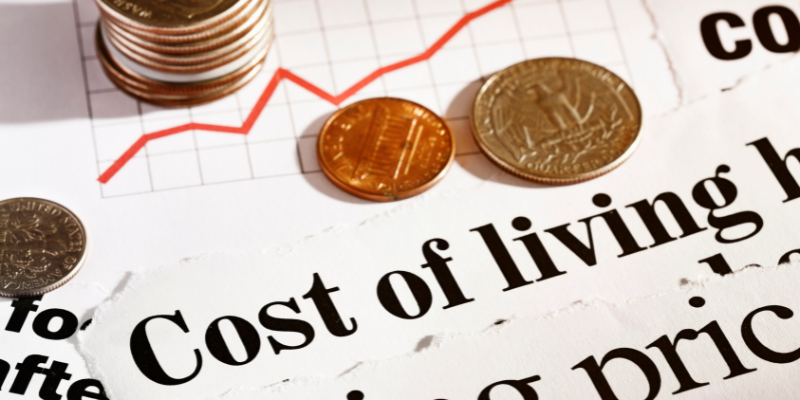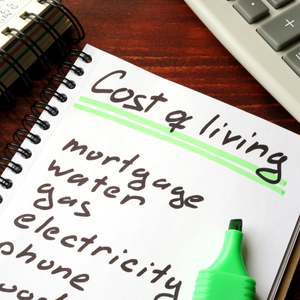
Saint Paul is one of the Twin Cities in the state of Minnesota, capturing the beauty of the Midwest while also embracing the love of culture and the conveniences of the city. This city is affordable in comparison to other metropolitan areas in the country and attracts many people, including families, students, young professionals, and retirees. Saint Paul is near other major cities in the country, and the affordability streamlines the process of major metropolitan areas. If people are looking to move, purchase a home, or want to understand the similarities and differences of homes in Saint Paul, understanding the cost of living in Saint Paul is essential to understanding the city.
Key Highlights
- The cost of living in St. Paul is cheaper than in most U.S. metropolitan areas and is overall less than in most major U.S. metropolitan areas.
- Home and rental prices are cheaper than in bordering Minneapolis and are also cheaper than in the major metropolitan coastal cities.
- Groceries, transportation, and healthcare are within the national averages, which allows for meeting a predictable monthly budget.
- Commuting is simple and cost-effective, with bus and light rail stations, bike paths, and highways available.
- Affordable living is also due to parks, cultural and educational institutions, and overall community facilities.
Overview of Saint Paul’s Cost of Living

Cost of living in Saint Paul is affordable, just slightly below the national average, as you will see. Housing prices have increased but are still far below the prices of coastal cities and popular migration hotspots. Many everyday essentials, such as groceries, utilities, transport, and health care, are reasonable, making Saint Paul a great place to live for those looking for a good standard of living but also looking for a good overall affordable value.
Cost of Living Breakdown Table
Understanding the cost of living in Saint Paul is easier when comparing major categories to the national average. Below is a simplified overview using an index where 100 represents the U.S. average.
| Category | Saint Paul Index | U.S. Average Index | Notes |
|---|---|---|---|
| Overall Cost | 99 | 100 | Slightly below national average |
| Housing | 93 | 100 | More affordable than many major U.S. metros |
| Utilities | 102 | 100 | Slightly higher due to cold winters |
| Transportation | 98 | 100 | Good transit options help reduce costs |
| Groceries | 101 | 100 | Slightly below the national average |
| Healthcare | 98 | 100 | Competitive medical costs |
| Miscellaneous | 100 | 100 | Typical expenses align with U.S. norms |
This breakdown shows that, while some costs, such as utilities, are slightly higher due to the climate, most categories remain close to or below the national average. Combined with affordable housing and reasonable everyday expenses, Saint Paul offers a well-balanced cost of living for a variety of residents.
Housing Costs in Saint Paul
Housing is the most significant expenditure for many residents. Saint Paul is fairly unique in being able to match people to every type of housing within the city. It is the only city in the Twin Cities to have converted a downtown to have apartments and still have fully developed suburban neighborhoods and a variety of detached single-family homes, including large and small Victorian homes. It has even been developed to the newest modern styles.
Key trends:
- Median home prices remain lower than in Minneapolis and well below national hot spots like Denver or Seattle.
- Rent is relatively stable, with many affordable options across the city.
- First-time homebuyers find the market more accessible compared to many large metropolitan areas.
Families and working adults looking for a home in the area with reasonable walking distance to stores and to open green spaces, including parks, have a choice of neighborhoods, including Highland Park, Como Park, and Macalester-Groveland. Those streets, including Frogtown and Payne-Phalen, offer higher-density housing at lower prices.
Utilities and Energy Costs

Minnesota’s long, bitterly cold winters raise heating costs, affecting utility bills. Saint Paul’s utility costs are close to the national average despite the heating burden. Saint Paul households pay $200–350 per month for electricity, natural gas, water/sewer, and trash collection. Electricity costs $80 to $200 per month, depending on the season and home size, while natural gas used for heating costs $60 to $150 in winter.
In Minnesota, residential water and sewer rates range from $40 to $60 per month. Saint Paul’s 2024–2025 rate schedule lists a $46.20 monthly water utility charge, but actual bills vary by meter usage. City garbage and recycling rates average $20–$40 per month for most households.
Residents often pay for the internet separately from other utilities. High-speed internet plans in Saint Paul cost $50 to $80 per month, depending on the provider and speed. Some households invest in energy-efficient upgrades like better insulation, smart thermostats, or more efficient heating systems to alleviate seasonal usage spikes and lower utility bills.
Transportation Expenses
Saint Paul residents enjoy several modes of transport, which assist in reducing commuting expenses. The city is served by Metro Transit, which has a network of buses and light rail that connect various neighborhoods and the downtown area. This has made public transport an economical option for people who travel in the city on a daily basis as well as for students.
Saint Paul is a bike-friendly city encouraging cycling as an inexpensive and practical means of transport. The city has a number of trails and bike lanes throughout the city, which reduces the need for a car as well as expenses associated with driving a car, like gas and parking.
Fuel and parking costs in the city for people who choose to drive are reasonable compared to those in larger East and West Coast cities. The city also has easy access to major highways, which makes driving and traveling to the suburbs quicker. People who have to drive daily also have reasonable costs and can enjoy the benefits of driving in a metropolitan area.
Food and Grocery Prices
Compared to the rest of the country, the grocery costs reflected in St. Paul make it reasonable for residents to plan for their daily meals. St. Paul grocery shopping also offers a valuable assortment of shopping alternatives, ranging from large shopping chains to small, individual specialty marketplaces. Residents can satisfy their weekly and daily shopping needs.
The valued grocery shopping options are stores, such as Cub Foods, Aldi, and Costco, that sell staple foods, household essentials, and a variety of other goods in bulk at low prices. Additionally, the town has partnered with a grocery co-op that operates an in-season farmers market, providing residents with access to higher-priced produce and specialty grocery items within close walking distance.
The St. Paul’s eat-out prices and food variety are within the same range as other restaurants. The more expensive restaurants on Grand Avenue and Downtown offer a good variety of foods that nearby, cheaper options do not.
Healthcare Costs
In comparison to other metropolitan areas in the United States, Saint Paul has one of the most affordable healthcare systems. Saint Paul has a range of healthcare systems that allow the residents to receive quality care in the fields of preventative, emergency, and specialized healthcare.
HealthPartners, Regions Hospital, and M Health Fairview, all of which operate in Saint Paul, are some of the most prominent healthcare organizations in the nation that provide both primary and specialty care. Access to care and the provision of primary care services provide peace of mind to residents, relieving anxiety about medical care.
Cost-sharing and plan premiums differ and are determined by the insurance plan, healthcare provider, and medical services received. Perennially, residents of Saint Paul spend less money than those in other large metropolitan areas in the United States, which lessens the economic burden of maintaining good health.
Taxes in Saint Paul, MN

Minnesota employs a progressive income tax system, so as people get paid more, they pay a higher percentage in income tax. Property taxes in Saint Paul are at a net neutral position in western contexts, being average around the nation. While these taxes may be higher than in other areas, they are also more than beneficial in funding services and amenities in the community.
Residents of Saint Paul have access to a number of public, well-maintained parks and recreational areas, which can also be used for community-organized/outdoor activities and sports. Public tax money is also used to maintain and create public educational facilities so that families have access to educational services and classrooms.
Taxes also go to funding public services and public transportation, which improve community services for Saint Paul. It can be seen that these services help make Saint Paul a safe, well-rounded, and busy location for people of all ages.
Lifestyle and Quality of Life
Saint Paul’s distinctive feature is the overall balance between the cultural amenities and the natural amenities. The city is also very well organized when it comes to maintenance. The numerous parks and green spaces are carefully taken care of and give the residents plenty of chances to engage in various outdoor pursuits. Numerous families and visitors enjoy places such as Como Park Zoo & Conservatory and Phalen Regional Park.
Saint Paul also has plenty of flourishing businesses in the realm of arts and entertainment. The local theaters, galleries, and music venues ensure that the residents are not absent from the cultural amenities. The city is very active and alive, thanks to the numerous festivals and events organized throughout the year.
Saint Paul has numerous family-friendly neighborhoods, which make it very appealing to people of all ages. The family-friendly neighborhoods paired with affordable housing, accessibility to all public services, and accessibility to many amenities make the city very appealing. This makes the overall balance of the city in terms of affordability, accessibility to amenities, and cultural options very appealing.
The cost of living in Saint Paul, MN, remains attractive in 2025. With affordable housing, manageable utility and grocery prices, reliable transportation, and a high quality of life, Saint Paul offers strong value compared to many major urban areas. Whether you’re relocating, investing in property, or simply researching, the city provides a balanced lifestyle with both affordability and comfort. If you’re evaluating Saint Paul for a move or investment, understanding these cost factors can help ensure your budget and expectations align with your long-term goals.
Do you need to sell your home in Saint Paul, MN? Whether you want to sell quickly, avoid costly repairs, or enjoy a hassle-free sale, Henry Home Buyer is here to help. As a trusted cash-for-houses company in Saint Paul and working with investor home buyers in Minneapolis, we provide fair cash offers, handle all the details, and make the process seamless. Contact (612) 430-8822 today for a no-obligation offer and sell your Saint Paul house faster.
FAQs
Is Saint Paul expensive to live in?
No. Saint Paul is slightly below the national average in overall cost of living, making it more affordable than large metros like Chicago, Seattle, or San Francisco.
Is housing affordable in Saint Paul?
Yes. Housing costs are lower than the U.S. average, and the city offers a wide range of rental and homeownership options.
How much do utilities cost in Saint Paul?
Utilities are slightly above the national average due to Minnesota’s cold winters but overall remain manageable for most households.
Does Saint Paul have good public transportation?
Absolutely. Residents can access bus routes, light rail lines, and bike-friendly streets, reducing the need for a car in many neighborhoods.
How does Saint Paul compare to Minneapolis?
Saint Paul is generally more affordable in terms of housing and offers a quieter, more historic charm compared to the more urban vibe of Minneapolis.
Helpful Saint Paul Blog Articles

